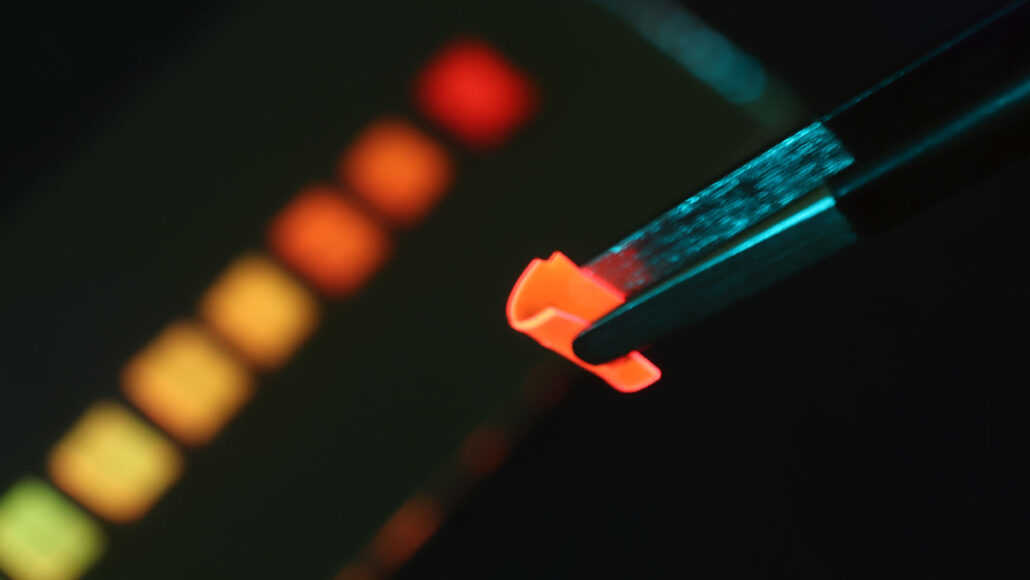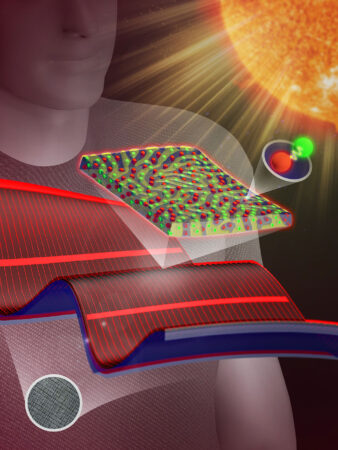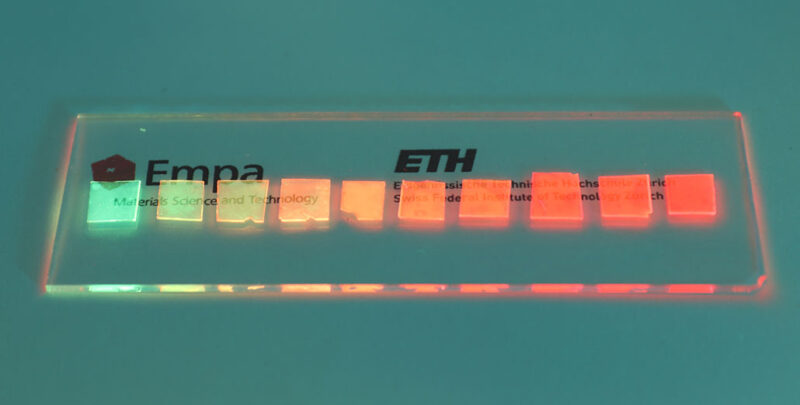Flexible devices may help clothes solar power your screens
Fancy chemistry uses tiny ‘puddles’ of dyes to boost the efficiency of solar cells

Bent by tweezers, a flexible solar concentrator emits red light when blue light is beamed onto it. The sun emits such wavelengths of light. If used to coat fabrics, such concentrators could harvest sunlight to power someone’s phone or other electronics.
Empa
By Shi En Kim
Imagine backpacking alone in the wild when your phone battery dies. No worries! The jacket you’re wearing can power it up. Your jacket’s fabric is a solar device. It can generate electricity from the sun to recharge your phone anytime. And new research has just brought that solar fabric a little closer.
This is Luciano Boesel’s goal: to make solar devices that are wearable. He’s a materials scientist at Empa. That’s the Swiss Federal Laboratories for Materials Science and Technology, in St. Gallen.

Solar cells are more efficient when used with a sidekick called a solar concentrator. As its name suggests, this device concentrates the sun’s rays onto solar cells. With a concentrator, fewer and smaller solar cells are needed to generate large amounts of electricity.
“Wearable solar cells are not at the same level as standard building solar cells,” notes Boesel. “They have lower efficiency.” Adding a solar concentrator, he says, “will increase the efficiency of the whole energy-generating device.”
His team has just made a flexible solar concentrator from an unusual material. It’s called an APCN. That’s short for amphiphilic (Am-FIH-fill-ik) polymer co-network. Because it can let water and oxygen move through it, it’s breathable and comfortable to wear. This material is already being used to make some contact lenses.
“It’s not only for wear, but also for any flexible use,” says Chieh-Szu Huang. He’s a materials scientist on the Empa team that’s designed the new solar concentrator. The ACPN material they use is versatile, he notes. “It can coat or fit into any shape.”
His team described its new solar-concentrating material June 19 in the journal Nano Energy.
Tiny, interconnected puddles
APCNs are made up of two different polymers. These two usually don’t mix with each other. Instead, they behave like water and oil. In fact, the same principle governs why the two polymers would rather avoid each other. One polymer loves water. The other hates water, just as oil does.
The two polymers would prefer to separate completely. But they can’t. The researchers have linked the two chemically. So now, at the nano- — or billionth-of-a-meter — scale, the polymers reshuffle to minimize contact. They form interconnected puddles of the water-loving polymer and water-hating polymer. Truly tiny, these puddles are less than a thousandth of the width of a human hair.
The researchers add a green dye to the water-loving puddles and a red dye to the water-hating ones. Both dyes fluoresce: They absorb light at one wavelength (or color) and emit it at a longer one. The dyes are useful because they convert light reaching the solar cells to wavelengths those solar cells can better use.

These dyes also can exchange light energy across different puddles. It helps that the puddles are so tiny. This increases their success at trapping light and passing it on to the solar cell, explains Huang. Their action makes the entire system (concentrator and solar cell) better at harvesting light. In fact, the APCN material can boost the efficiency of a silicon solar cell by up to 24 percent, Empa’s scientists report.
“[Solar concentrators] can easily couple to existing solar technology,” observes Haley Bauser. She’s an applied physicist at the California Institute of Technology in Pasadena. Solar concentrators are much cheaper than solar cells, she notes. As such, she says they’re an easy way to boost the efficiency of solar cells.
Polymers that can flex, as APCNs can, are suited for specialized applications. Bauser points to one example: harvesting solar energy in space. The devices used there will need to be flexible and lightweight, she says.
The Empa team plans to keep improving its solar concentrators. In the future, these researchers hope to produce real-life solar wearables. A solar jacket might not be far-fetched, says Huang. So, outdoor lovers, stay tuned.







